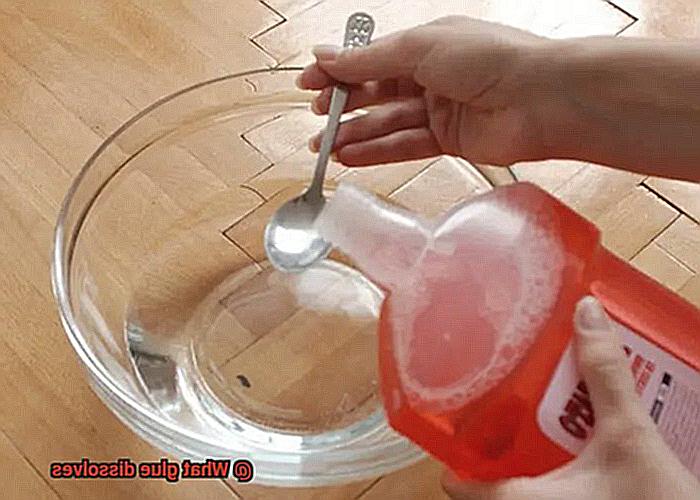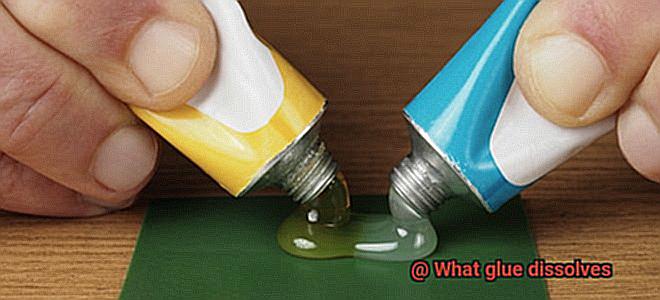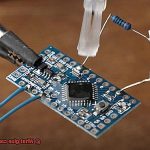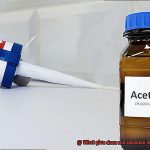Have you ever been in a sticky situation, trying to remove glue from your clothes or furniture? Or maybe you’ve had a crafting mishap, with glue sticking to everything except what it’s supposed to be bonding. We’ve all been there, but fear not – knowing what glue dissolves can be a total game-changer, saving you time and frustration.
It’s important to note that different adhesives have varying chemical properties, so it’s crucial to identify the type of glue you’re dealing with before attempting to dissolve it. For instance, super glue requires acetone or nail polish remover to break down while hot glue can be dissolved with rubbing alcohol or vinegar. On the other hand, white glue (a.k.a school glue) can be dissolved with water or a mixture of water and vinegar.
However, not all glues are easily dissolved. Some are designed to be permanent, such as epoxy which requires a specialized solvent for breakdown. Others may require more caution when dissolving, like contact cement which should never be exposed to direct heat or flames. Understanding which substances dissolve specific types of glues is key in removing stubborn stains and making your DIY projects less complicated.
So whether it’s for practical cleaning purposes or avoiding future headaches, take some time to learn what dissolves what type of adhesive and make your life that much easier.
Types of Glue
Contents
Understanding the different types of glue and how to dissolve them can come in handy when tackling DIY projects or dealing with unexpected mishaps.
First on the list is PVA glue, also known as white glue. This water-based adhesive is commonly used for paper, wood, and fabric, making it a staple in any crafter’s toolbox. To dissolve PVA glue easily, simply soak a cloth in warm water and place it over the glue for a few minutes. The glue will soften, making it easier to wipe away.
Next up is hot glue – a thermoplastic adhesive that is melted and applied using a hot glue gun. Hot glue is a versatile adhesive that can bond almost anything but can be tricky to remove. However, acetone or nail polish remover can work wonders in dissolving hot glue. Simply apply the solvent to the affected area and wait for a few minutes before wiping it away.
Epoxy glue is a two-part adhesive that consists of a resin and a hardener. This type of glue is popular among DIY enthusiasts and professionals alike due to its strength and versatility. While vinegar and baking soda mixture or acetone can dissolve epoxy glue, remember that acetone can damage certain surfaces, so use this method with caution.
Cyanoacrylate glue, commonly known as superglue, is every crafter’s go-to for quick fixes. This fast-drying adhesive requires a bit more effort to dissolve. Acetone or nail polish remover can do the trick, but it may take some time for the solvent to break down the bond.
Lastly, contact cement is a strong adhesive commonly used for bonding laminates, veneers, and plastics. This type of glue creates an almost unbreakable bond but can be dissolved using acetone or mineral spirits. Again, be cautious when using acetone as it can cause damage to certain surfaces.
Water-based Glue
As an expert in this area, I’m here to share some tips on how to dissolve water-based glue with ease.
Water-based glue, also known as PVA glue, is a popular adhesive because of its strength and versatility. However, it can be dissolved with the right materials. This type of glue is made from a water-soluble polymer that forms a strong bond when it dries.
One of the most effective ways to dissolve water-based glue is with warm water. Simply soak the glued object in warm water for several hours or overnight to break down the adhesive and make it easier to remove. This method is particularly useful for removing glue from delicate materials like fabrics.
If you’re looking for another option, vinegar or a vinegar solution can be your savior. The acetic acid in vinegar helps to break down the glue and make it easier to remove. Just apply vinegar to the glued area and let it sit for several minutes before wiping away with a damp cloth.
For hard surfaces like countertops or floors, rubbing alcohol can be used to dissolve water-based glue. Apply rubbing alcohol to the glued area and let it sit for several minutes before wiping away with a clean cloth.
Solvent-based Glue
Look no further than solvent-based glue, also known as contact cement. This powerful adhesive forms an immediate and strong bond between two surfaces, making it a go-to choice for bonding materials such as rubber, leather, metal, and wood.
However, once the glue dries up, it can be difficult to remove. That’s where solvents come in. Solvents dissolve and soften the glue, making it easier to wipe away. But what exactly are these solvents made of?
The solvents used in solvent-based glue are typically volatile organic compounds (VOCs) such as acetone, toluene, or xylene. While effective at dissolving the glue, these solvents can have negative environmental and health impacts if not handled properly. It’s important to use them in a well-ventilated area and wear protective equipment like gloves and a respirator.
Acetone is the most commonly used solvent for dissolving solvent-based glue. It can be found in nail polish remover or hardware stores. Other options include methyl ethyl ketone (MEK), toluene, and xylene.
To dissolve the glue, simply apply the solvent to the affected area and let it sit for a few minutes. The solvent will do its job and break down the glue, making it easy to wipe away with a cloth.
Dissolving Water-Based Glue
Are you tired of struggling to remove stubborn water-based glue residue from surfaces? As an expert in this field, I have compiled some helpful tips and tricks to make this task a breeze.
Warm water and soap are a great go-to for dissolving water-based glue. Simply mix warm water and dish soap in a bowl or container and soak the affected area for several minutes. The warm water helps to break down the glue, while the soap helps to lift it off the surface. This gentle method is perfect for use on fabrics or paper.
For tougher jobs, vinegar is an excellent option. Vinegar is an acid that breaks down the bonds in the glue, making it easier to remove. To use this method, mix equal parts vinegar and warm water in a bowl or container and soak the affected area for several minutes. After soaking, scrape away any leftover glue residue with a plastic scraper or credit card.
Rubbing alcohol is another effective solvent for dissolving water-based glue. Like vinegar, rubbing alcohol breaks down the bonds in the glue, making it easier to remove. Soak a cloth or cotton ball in rubbing alcohol and apply it to the affected area, letting it sit for several minutes before wiping away the glue residue.
It’s important to note that not all solvents will work on all types of surfaces. Before using any new cleaning solution on a larger scale, test it on a small inconspicuous area first.
Dissolving Hot Glue
Fear not. As an expert in the field, I have researched and compiled some helpful tips and safety precautions to make this task easier and ensure your project’s success.
One of the most effective ways to dissolve hot glue is by using acetone. Acetone is a potent solvent that breaks down the chemical bonds in hot glue, making it easier to remove. To use this technique, apply acetone to the glue and let it sit for a few minutes. However, be aware that acetone can be harmful to some materials like plastics, so it’s essential to test it on a small, inconspicuous area before applying it to larger surfaces.
Another method for dissolving hot glue is by using rubbing alcohol. Rubbing alcohol contains isopropyl alcohol, which can also break down the chemical bonds in hot glue. Simply apply the rubbing alcohol to the glue and let it sit for a few minutes. You’ll see how the glue starts to soften and become easier to remove.
Remember that there are other solvents that can be used to dissolve hot glue, such as nail polish remover or vinegar. However, these solvents may not be as effective as acetone or rubbing alcohol and may not work on all types of hot glue.
When using any solvent, it’s crucial to follow safety precautions such as wearing gloves and working in a well-ventilated area. Always test on a small, inconspicuous area before using it on a larger surface.
Dissolving Solvent-Based Glues
As an expert in dissolving glue, I can guide you through the process and provide you with some fascinating insights on the topic.
Solvent-based glues are commonly used in industrial settings due to their strong bonding power and versatility. However, these adhesives can be challenging to dissolve. But don’t worry, there are solvents available that can do the job effectively.
One of the most common solvents used to dissolve solvent-based glues is acetone. This colorless liquid has a strong odor and can dissolve many different types of adhesives. However, it’s crucial to work in a well-ventilated area and wear gloves to protect your skin when using acetone. This potent solvent can work wonders but requires proper handling.
Another effective solvent for dissolving solvent-based glues is methyl ethyl ketone (MEK). This clear liquid has a sweet odor and can dissolve various types of adhesives and coatings. When using MEK, it’s essential to follow safety precautions such as wearing gloves and working in a well-ventilated area. MEK is a powerful solvent that deserves respect.

There are other solvents that you can use to dissolve solvent-based glues, including ethyl acetate, toluene, and xylene. These solvents are toxic and should be used with caution. It’s essential to follow the manufacturer’s instructions carefully and consult with an expert if you’re unsure about how to use a particular solvent. Remember, safety first.

Tips for Dissolving Glue Safely and Effectively
Whether it’s removing adhesive labels from jars or getting rid of sticky residue from a DIY project, dissolving glue can be a tricky task. But don’t worry, we’ve got you covered. When it comes to dissolving glue safely and effectively, there are some tips you can follow to get the job done without causing any harm or damage.
Prioritize Safety
When working with any type of solvent, always prioritize safety. Different types of glue require different solvents, so it’s important to read the product label carefully before choosing a solvent. When handling glue solvents, wear protective gloves and eyewear to prevent any accidental contact with the skin or eyes. This will protect you from any harmful chemicals that may be present in the solvents.
Work in a Well-Ventilated Area
When using glue solvents, it’s crucial to work in a well-ventilated area. Some solvents emit strong fumes that can be harmful if inhaled in large quantities. Therefore, it’s best to work in a room with open windows or use a fan to circulate air. This will help prevent any respiratory issues or headaches that may be caused by inhaling the fumes.
Use Heat with Caution
One common method for dissolving glue is using heat, but it should be used with caution. Applying a hot, damp cloth to the glued area or using a hairdryer on a low heat setting can help dissolve the glue. However, it’s important to be careful not to burn yourself or cause damage to surrounding surfaces.
Be Careful with Mechanical Removal
In some cases, mechanical removal may be necessary for stubborn glue residue. This can be done using a scraper or sandpaper, but again, caution should be taken to avoid damaging surrounding surfaces. It’s essential to take your time and work carefully to avoid causing any harm or damage.
Clean Thoroughly after Removal
After dissolving the glue, it’s vital to clean the surface thoroughly with soap and water to remove any residue. This will help ensure that the surface is ready for any further treatment or use. Plus, it will leave the surface looking clean and free of any sticky residue.
_59ZzuLJcTw” >
Also Read: Is Super Glue Waterproof? – Glue Things
Conclusion
In conclusion, understanding what glue dissolves can be a total game-changer for your DIY projects. The right knowledge can save you time and frustration, making your crafting experience much more enjoyable. It’s important to note that different adhesives have varying chemical properties, so it’s crucial to identify the type of glue you’re dealing with before attempting to dissolve it.
Water-based glues like PVA glue are relatively easy to dissolve with warm water or a mixture of vinegar and water. On the other hand, solvent-based glues like contact cement require acetone or other volatile organic compounds as solvents. However, not all glues are easily dissolved, and some may require more caution when dissolving.
Understanding which substances dissolve specific types of glues is key in removing stubborn stains and making your DIY projects less complicated. When working with any type of solvent, always prioritize safety by wearing protective gloves and eyewear and working in a well-ventilated area. Use heat with caution and be careful with mechanical removal to avoid damaging surrounding surfaces.
Finally, after dissolving the glue, clean the surface thoroughly with soap and water to remove any residue. By following these tips for dissolving glue safely and effectively, you can ensure that your DIY projects turn out just as you envisioned them without any accidents or mishaps along the way.
So there you have it – an expert guide on what glue dissolves. Armed with this knowledge, you’ll be able to tackle even the toughest adhesive challenges with ease.






